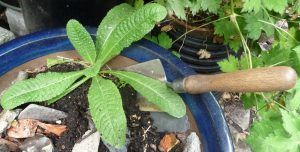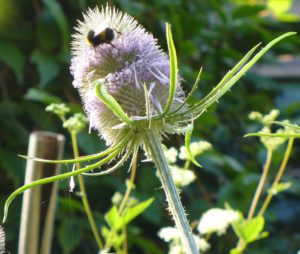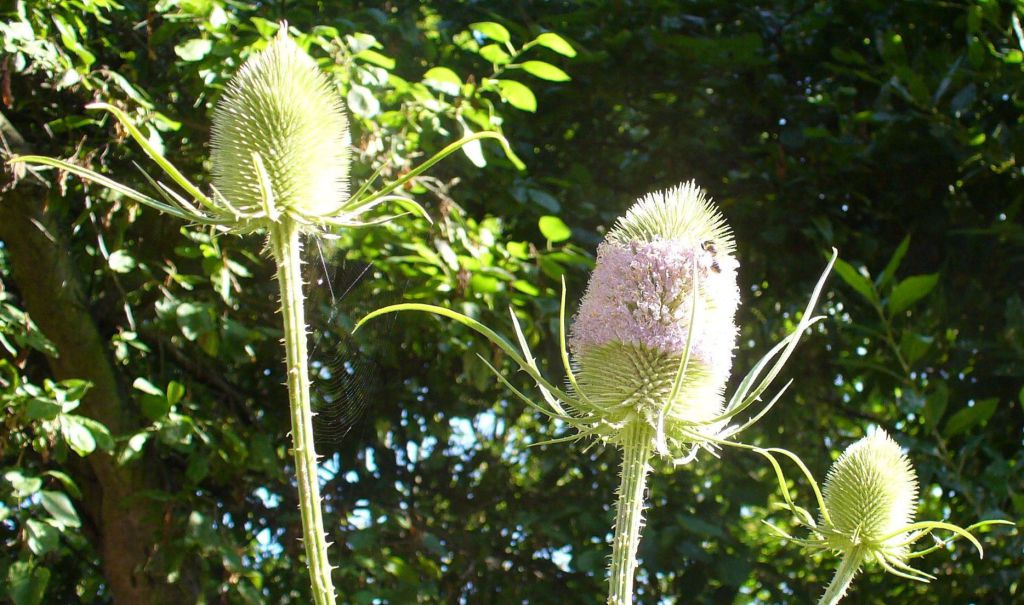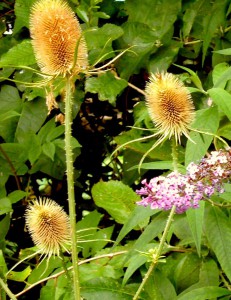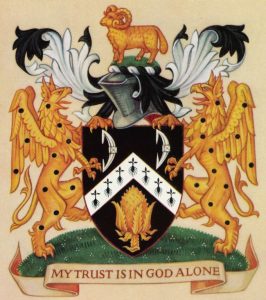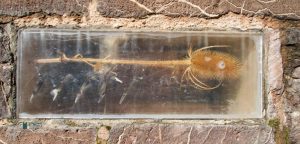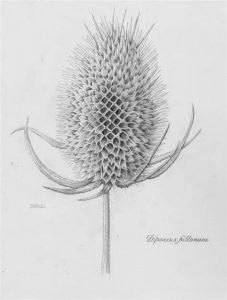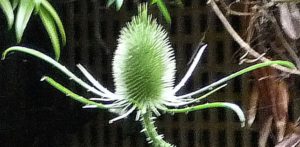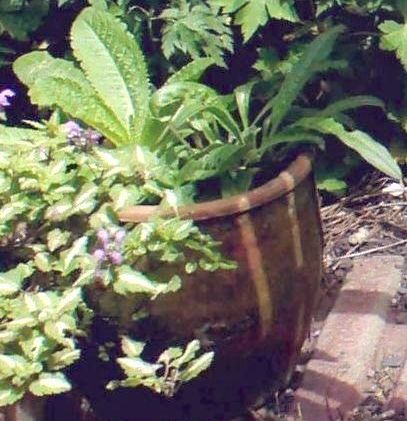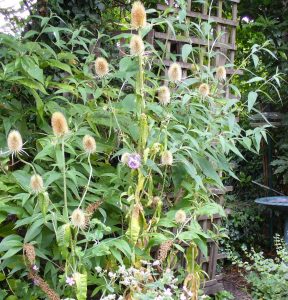TEASEL (Dipsacus fullonum)
Europe, N Africa, W Asia
The Teasel is a tall, stately, spiky wildflower that can reach 7 feet in height. It is biennial, beginning its life as a rosette of leaves lying flat to the ground.
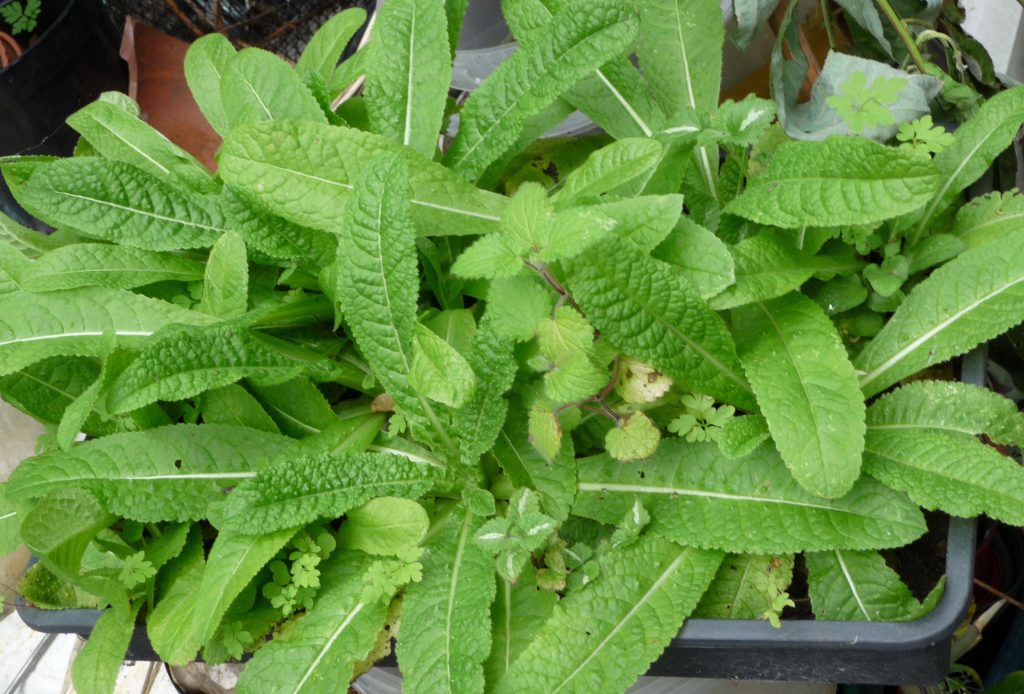
The surface of each rounded leaf is a pattern of folds, bumps & prickles. And so it remains in its first year. During this time the Teasel can easily be pulled up and moved to a sunny spot that will allow space for its size as an adult, & keep any passing humans safe from contact with its spikiness.
Wearing gloves is advised, however, as even these young leaves have prickles.
In its second year the Teasel grows like Jack’s beanstalk. The rounded leaves become daggers, with prickles running from the spiny stem down to the now-pointy leaf tips. Rainwater collects in the joins where the leaves clasp the stem, a feature of this plant ; its botanical name, Dipsacus fullonum, comes from the Greek ‘dipsa’, for thirst.
Barbed now & protected from grazing animals, the prickly Teasel is free to grow. It becomes an intimidating entity when fully grown, reaching nearly 7 feet. The flower heads – spiky green, eggshaped ‘thistles’ – appear at its stem tips. Small LAVENDER PINK flowers form round these egg thistles.
‘Grow Teasel Plants in any fertile, moist soil, including heavy clay soils. Water Teasel plants regularly until fully established. Dipsacus fullonum will self-seed freely. If seedlings are not wanted, deadhead stems of Teasel flowers as the blooms fade.’ GOOGLE
Bees’ Favourite
Tiny flowers appear in bands around the Teasel’s egg-shaped flower heads, attracting bees & butterflies such as the Red Admiral & the Comma.
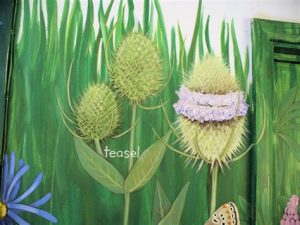
Teasel on wildflower mural, Ecology Centre, Gillespie Park
“The flower head is the size and shape of an upturned egg cup, covered in soft green bristles at this stage. and the flowers open just like a MAUVE belt around the middle. This first band of miniature blossoms lasts a day or two and, as it fades, a pair of replacement rings opens, one above and one below. As the week goes by, the two bands of flowers move wider and wider apart, until all of the flowers have been pollinated and the performance is over.
The colour of the Teasel pollen is deep lavender/pink, and there is a great deal of it. Big bumblebees seem to be the main pollinators, and they look like rather overweight punk rocker ‘wall of death’ riders as they crawl horizontally around each belt of flowers, covering themselves with pink pollen.” Chris Baines, How to Make a Wildflower Garden, Elm Tree Books/Hamish Hamilton, 1985.
Historical
In the Victorian era, The Language of Flowers (floriography) assigned certain qualities to plants & flowers. Dictionaries were printed listing the flowers and their meanings. The Teasel was given ‘Misanthropy’ as its quality. Anyone brushing against one might be forgiven for thinking it had a grudge against humanity… Secret Flower Meanings Defined From A to Z – Gardening Channel – Mozilla Firefox
Teazles were employed in the cloth-making industry at least as far back as the Middle Ages, as they are mentioned in John Langland’s “Piers Plowman” of 1377.” A rough translation – “Cloth that comes from the weaving is in no way good to wear until it is fulled… and with the teazel scratched.”
http://herbs-treatandtaste.blogspot.co.uk/2011/07/teazle-brushes-and-combs-history-of-use.html
In ancient Ireland, teasel was used as a first layer for thatched roofs. The spines on the stems helped hold the other materials in place. They also made some very ferocious looking brooms for sweeping the bad spirits from the home and teasel hung above the doorway prevented witches from entering. Apparently the ferocious spines were enough to deter the bad spirits that might enter the home.
Teasel was the companion plant to the Nordic and Germanic domestic goddess Hulda/Holda. She was in charge of the household and was especially important to spinning and textiles
Melody Rose, Dave’s Garden, June 18, 1996. https://davesgarden.com/guides/articles/identifying-weeds-teasel-dipsacus-fullonum
The prickly heads were used for combing – ‘teasing’ – the knots out of sheep’s wool.’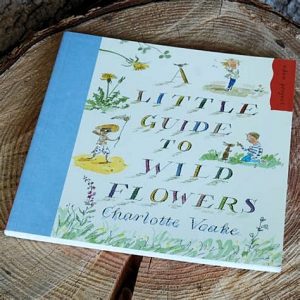
A LITTLE GUIDE TO WILD FLOWERS, Charlotte Voake
https://www.edenproject.com/shop/A-Little-Guide-to-Wild-Flowers.aspx
The Teasel played its part in the Medieval English Clothmaking Industry, which brought prosperity to towns like Exeter.
‘In medieval cloth production the teasel heads were set upon a frame which could be pulled across a cloth… This important product of the woollen cloth industry stimulated a trade in teasels. In the 14th century they were being exported from England to the Low Countries, which caused a problem in a teasel shortage. In 1326 Edward II, as part of the terms of The Ordinance of the Staple, banned the exporting of ‘Tasles’. The demand for the English cloth industry required that teasels be imported. An early consignment example was that of 1331-1332 when 18,000 teasels landed at Exeter in a ship with woad and weld (used for dyes)…’
https://www.exploringbuildinghistory.co.uk/the-teasel-in-the-english-woollen-cloth-industry/
;
Medicinal
”Teasel is widely used in traditional Chinese Medicine as a liver and kidney toner. Teasel root is categorized as a Yang tonic with an affinity for assisting with structural repair especially of connective tissue and bone. It increases circulation and aids in building strong tendons and bones.” https://www.healthbenefitstimes.com › teasel
”Teasel, Dipsacus fullonum, is a spiny plant with an ominous past. The Iroquois considered the root poisonous and treated it accordingly to poison an enemy and even the innocent. The water gathered in the base of the leaves was used as a wash for acne and to cool inflammation of the eyes.” https://www.cargocultcafe.com › teasel
Teasel root can also be used to treat depression, exhaustion, feelings of despair, low willpower, apathy, mental fog and memory problems. It can promote neuronal health and prevent neuronal death as well as helping with Alzheimer’s Disease and Dementia. https://mindbodyyes.com › teasel-root-health-benefits
Other uses
A blue dye obtained from the dried plant is an indigo substitute. It is water soluble. A yellow is obtained when the plant is mixed with alum. Teasels are also occasionally grown as ornamental plants, and the dried heads are used in floristry.
PFAF Plants for a Future database – Mozilla Firefox. Dipsacus fullonum teasel, Fuller’s Teasel.
Highbury – Our Garden’s First Teasel
The first Teasel to grace our garden shared a terracotta pot with a Vipers Bugloss. Both are excellent bee plants, but we had not anticipated the size each would reach in their second years.
The Teasel, seen here on the left in their first year, dominated the Vipers Bugloss & was declared the winner of the battle for the pot. Echium vulgare had to be removed & planted out elsewhere.
The Teasel’s thick tap root must have been frustrated living in a container. Sue from Archway assured us we would always have teasels now… She has a front garden full of them… But she does not have our wildlife pecking up all the Teasel seeds.
Other names: Adam’s Flannel, Card Teasel, Church Broom, Cut-leaved Teasel, Draper’s Teasel, Gypsy-combs, Hair-Brush, Indian Teasel, Johnny-prick-the-finger, Lady’s Brush and Comb, Lady’s Brushes, Little Brushes, Prickly Back, Teazel, Teazle, Venus’ Basin, Venus’ Cup, Wild Teasel. France: Bonnetier, Cabaret des oiseaux, Cardaire sauvage, Cardere des bois, Cardere sylvestre, Chardon des fores, Sauvage. Germany: Kardendistel, Kardvadd, Kratzkopf, Walde Karde, Weberdistel. Spain: Bano de Venus Card, Cardencha Cardo, Carda de Cardadores, Cardoncha, Dipsaco Peines, Raspasayo, Vara de Pastor.
Warning – Prolific Maker of Seeds
Dipsacus fullonum will grow in most soils, & each prickly head can produce as many as 2,000 seeds. In this garden our wildlife eats most of the plant’s seeds, but a few usually survive to become new Teasels the following spring. The plant has been introduced elsewhere, such as the USA, where it may overwhelm native plantlife. It is now considered an invasive species in Washington State.
In Christopher Lloyd‘s garden at Great Dixter, Teasels planted in the massive flowerbeds are left – dried, brown and dramatic – after the plants have finished flowering.
Here, in our somewhat more modest garden, we too leave the dried remains of our Teasels to stand through the coming winter.
VIDEO – COMMA BUTTERFLY ON TEASEL
VIDEO – TEASEL IN BLOOM, LATE AFTERNOON
VIDEO – SPENT TEASELS AT GREAT DIXTER

